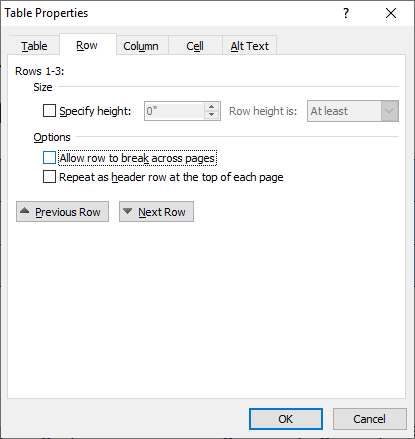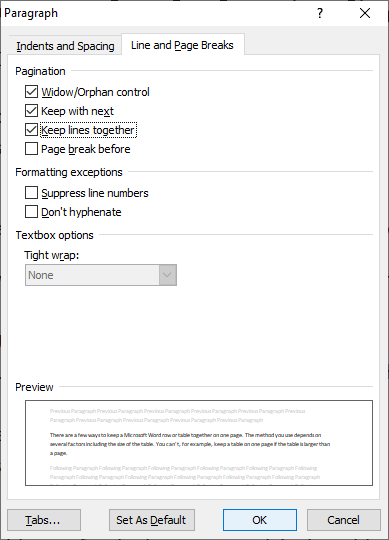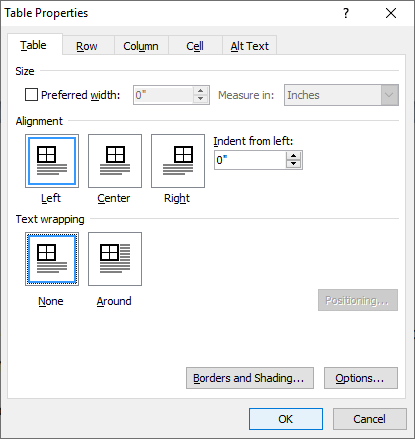Stop a Microsoft Word Table or Row from Breaking Across Pages
by Avantix Learning Team | Updated August 21, 2022
Applies to: Microsoft® Word® 2010, 2013, 2016, 2019, 2021 and 365 (Windows)
There are a few ways to keep a Microsoft Word row or table together on one page. When you want to stop a Word table from breaking across pages, the method you use depends on several factors including the size of the table. You can't, for example, keep a table on one page if the table is larger than a page. Here, we're also assuming the table is in the body of the document, not the header or footer.
Note: Buttons and Ribbon tabs may display in a different way (with or without text) depending on your version of Word, the size of your screen and your Control Panel settings. For newer versions of Word, Ribbon tabs may appear with different names. For example, the Table Tools Design tab may appear as Table Design.
Recommended article: How to Format Microsoft Word Tables Using Table Styles (Ultimate Guide)
Do you want to learn more about Microsoft Word? Check out our virtual classroom or in-person classroom Word courses >
Stop a table row from breaking across pages using Table Properties
If you want to simply stop a table row from breaking across pages, you can change the Table Properties:
- Select the row or rows that should not break across pages (you may want to select the entire table).
- Click the Table Layout or Table Tools Layout tab in the Ribbon.
- Click Properties. You can also right-click and choose Properties from the context-sensitive menu. A dialog box appears.
- Click the Row tab. Uncheck the check box to Allow row to break across pages.
- Click OK.
Below is the Table Properties dialog box with the Row tab selected:
Keep table rows together by keeping lines and paragraphs together
Another way to keep a table row or rows together is to force paragraph(s) in cells to keep with the next paragraph(s) and / or to keep the lines of paragraph(s) together. A paragraph is anything with a hard return after it. Also, it's usually a good idea to turn on Show/Hide ¶ (which appears in the Paragraph group on the Home tab in the Ribbon).
To keep a row or rows together using the keep with next paragraph and / or keep lines together settings:
- Select the cell or cells with the paragraph(s) you wish to keep with next paragraph and keep lines together.
- Click the Home tab in the Ribbon.
- Click the dialog box launcher on the bottom right of the Paragraph group. The Paragraph dialog box appears.
- Click the Line and Page Breaks tab.
- Check Keep lines together to keep the lines of each paragraph together in the cell or cells you've selected.
- Check Keep with next to keep each paragraph in the cell or cells you've selected with the next paragraph. It's usually best not to turn this option on for the last paragraph in the table as it will keep the paragraph in the last cell with the next paragraph following the table.
- Click OK.
Below is the Paragraph dialog box with the Line and Page Breaks tab selected:
Keep a table together by starting it on a new page
Another way to keep a table together is to force the first paragraph in the table to start on a new page.
To force the first paragraph in a table to start on a new page:
- Select the first paragraph in the table.
- Click the Home tab in the Ribbon.
- Click the dialog box launcher on the bottom right of the Paragraph group. The Paragraph dialog box appears.
- Click the Line and Page Breaks tab.
- Check Page break before.
- Click OK.
By the way, if you're comfortable with styles, you could also use various paragraph settings in styles in your tables.
Other issues
If you've tried the strategies above and a table is still breaking across pages, there could be a number of reasons.
Ensure that the table is set so that it does not wrap around other text:
- Click in the table.
- Click the Table Layout or Table Tools Layout tab in the Ribbon.
- Click Properties. You can also right-click and choose Properties from the context-sensitive menu.
- In the Table Properties dialog box, click the Table tab.
- Click None under Text wrapping.
- Click OK.
Below is the Table Properties dialog box with the Table tab selected:
If a row is still breaking across pages, you may need to turn off the exact row height option:
- Select the row or rows that should not break across pages (you may want to select the entire table).
- Click the Table Layout or Table Tools Layout tab in the Ribbon.
- Click Properties. You can also right-click and choose Properties from the context-sensitive menu. A dialog box appears.
- Click the Row tab. Uncheck the check box to Allow row to break across pages.
- Uncheck Specify Height.
- Click OK.
You can also check for manual page breaks or section breaks in the table and delete them. However, be very careful deleting section breaks as they contain all information for the section.
To delete a page break or section break that has been inserted within a table:
- Ensure Show/Hide ¶ is turned on (which appears in the Paragraph group on the Home tab in the Ribbon).
- Select the problem page break or section break by dragging over it.
- Press Delete.
There can be some other issues like overly large indents in Table Properties so it's worth checking the properties if you're still having problems.
Subscribe to get more articles like this one
Did you find this article helpful? If you would like to receive new articles, JOIN our email list.
More resources
4 Ways to Create a Table in Word
How to Create a Table Template in Word
How to Create a Table of Contents in Word
How to Make Columns in Word (Newspaper-style)
How to View Word Count in Microsoft Word (4 Ways)
Related courses
Microsoft Word: Intermediate / Advanced
Microsoft Excel: Intermediate / Advanced
Microsoft PowerPoint: Intermediate / Advanced
Microsoft Word: Long Documents Master Class
Microsoft Word: Styles, Templates and Tables of Contents
Microsoft Word: Designing Dynamic Word Documents Using Fields
Our instructor-led courses are delivered in virtual classroom format or at our downtown Toronto location at 18 King Street East, Suite 1400, Toronto, Ontario, Canada (some in-person classroom courses may also be delivered at an alternate downtown Toronto location). Contact us at info@avantixlearning.ca if you'd like to arrange custom instructor-led virtual classroom or onsite training on a date that's convenient for you.
Copyright 2024 Avantix® Learning
You may also like
How to Insert or Type I with an Accent Mark in Word (Í, í, Ì, ì, Î, î, Ï, or ï)
You can insert or type i with an accent mark in Word using built-in tools or keyboard shortcuts (including Alt code shortcuts). The letter i can be inserted with an accent in both upper or lower case. The following are common accented characters that you can insert or type in Word in upper or lower case: grave (Ì or ì), acute (Í or í), circumflex (Î or î) and umlaut (Ï or ï).
How to Insert or Type A with an Accent Mark in Word (À, Á, Â, Ä, à, á, â, or ä)
You can insert or type a with an accent mark in Word using built-in tools or keyboard shortcuts (including Alt code shortcuts). The letter a can be inserted with an accent in both upper or lower case. The following are common accented characters that you can insert or type in Word in upper or lower case: grave (À or à), acute (Á or á), circumflex (Â or â) and umlaut (Ä or ä).
10 Word Shortcuts to Select Text Using a Keyboard
You can use several shortcuts in Word to select text in your documents using only your keyboard. When you select text, it will typically be highlighted in grey. After you select text, you can cut, copy, or delete the selected text or apply character or paragraph formatting.
Microsoft, the Microsoft logo, Microsoft Office and related Microsoft applications and logos are registered trademarks of Microsoft Corporation in Canada, US and other countries. All other trademarks are the property of the registered owners.
Avantix Learning |18 King Street East, Suite 1400, Toronto, Ontario, Canada M5C 1C4 | Contact us at info@avantixlearning.ca










